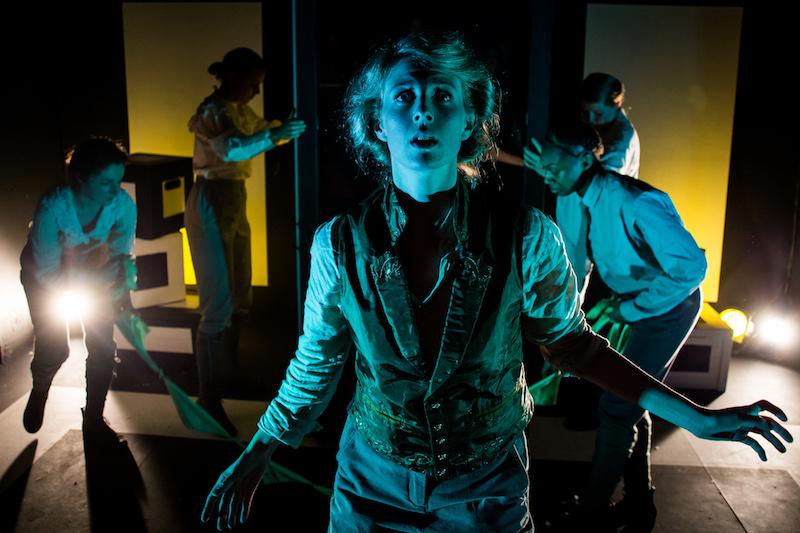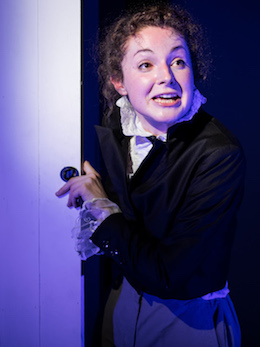Square Rounds, Finborough Theatre review - the science behind warfare, told in verse | reviews, news & interviews
Square Rounds, Finborough Theatre review - the science behind warfare, told in verse
Square Rounds, Finborough Theatre review - the science behind warfare, told in verse
Didactic theatre piece stronger on facts than drama

The title of Tony Harrison's teacherly entertainment – it can't be called a play – refers to the square bullets invented by James Puckle to kill Muslims in the 18th century. This shocking morsel of information is provided by the brothers Hiram and Hudson Maxim, inventors respectively of the machine gun and smokeless gunpowder, who are two of the characters in Square Rounds.
That apparent oxymoron might also imply attempts to square impossible circles, to the irony of scientific curiosity so frequently leading simultaneously to beneficial and destructive ends. Hiram Maxim (played energetically by Letty Thomas) invented an inhaler for asthmatics as well as a mousetrap, a sprinkler system and various pumps and motors besides the gun which takes his name. Then there is the irony of the scientists determined to believe that their creative killing methods are for the ultimate good of mankind.
 Square Rounds was first presented in 1992 on the Olivier stage as an informative extravaganza, all-singing, all-dancing, full of colour and magic, revelling in the resources of the National Theatre. The Finborough version, produced by Proud Haddock in association with Neil McPherson, is its first revival and is, of necessity, small-scale. The cast of 27 actors and musicians is replaced by only six, the razzamatazz mostly missing, but the essentials of the piece are there. There is even some simple magic – handkerchiefs change colour, candles disappear – and the young actors, all clearly having a ball, occasionally burst into song. More often they are handling rhythmic verse, gleefully pointing up insistent rhymes. The original cast was overwhelmingly female; now it is entirely so.
Square Rounds was first presented in 1992 on the Olivier stage as an informative extravaganza, all-singing, all-dancing, full of colour and magic, revelling in the resources of the National Theatre. The Finborough version, produced by Proud Haddock in association with Neil McPherson, is its first revival and is, of necessity, small-scale. The cast of 27 actors and musicians is replaced by only six, the razzamatazz mostly missing, but the essentials of the piece are there. There is even some simple magic – handkerchiefs change colour, candles disappear – and the young actors, all clearly having a ball, occasionally burst into song. More often they are handling rhythmic verse, gleefully pointing up insistent rhymes. The original cast was overwhelmingly female; now it is entirely so.
The premise is that "munitionettes", stuffing canisters with TNT in the First World War, morph into historical figures to tell the story of their place in scientific warfare. The most significant of these, so horribly up-to-date from Syria to Salisbury, is Fritz Haber's chemical weapon, chlorine gas. It is extra resonant in the anniversary year of the end of the Great War: in a graphic moment the cast simply file across the stage, blindfolded, as in a Paul Nash painting. And, in a further irony, the gas will later be used by Hitler to kill Haber's fellow Jews. But Haber's other important invention was fertiliser, a beneficial use of chemicals which still helps to feed the world. Philippa Quinn plays him with the right mixture of sincerity and arrogance, and it is her scene with a passionate Gracie Goldman as Clara (pictured below, right), Haber's suicidal wife – herself a brilliant chemist – which comes nearest to true drama. Meaningful interaction between characters is otherwise rare. Clara sees that gas is not a more benign weapon than guns and would not shorten the suffering of the war, but having failed to persuade her husband, she shoots herself.
 The set has a toilet cubicle-cum-magic box at its centre. The proper ecological use of human waste is again a live topic, as it was in 1992 and 1850. Eva Feiler as Justus von Liebig (pictured above, left), founder of organic chemistry and proponent of nitrogen (available from excrement) in fertiliser, is fervent and funny, capturing the verse rhythm conversationally and matching it with a winning physicality.
The set has a toilet cubicle-cum-magic box at its centre. The proper ecological use of human waste is again a live topic, as it was in 1992 and 1850. Eva Feiler as Justus von Liebig (pictured above, left), founder of organic chemistry and proponent of nitrogen (available from excrement) in fertiliser, is fervent and funny, capturing the verse rhythm conversationally and matching it with a winning physicality.
Director Jimmy Walters, whose production of Harrison's earlier more exuberant piece, The Trackers of Oxyrhynchus, sold out here a couple of years ago, oversees some neat ensemble work. And Depi Gorgogianni, movement director, ensures some deft circling around the black-and-white cubes of Daisy Blower's flexible set.
The bones of several fascinating plays lie buried here, waiting to be clothed in Harrison's robust, rhythmic, refulgent language. But for all its quirkiness and ambition, Square Rounds remains a superior example of theatre-in-education, albeit here delivered in an intimate seminar room rather than a lecture hall.
rating
Explore topics
Share this article
The future of Arts Journalism
You can stop theartsdesk.com closing!
We urgently need financing to survive. Our fundraising drive has thus far raised £49,000 but we need to reach £100,000 or we will be forced to close. Please contribute here: https://gofund.me/c3f6033d
And if you can forward this information to anyone who might assist, we’d be grateful.

Subscribe to theartsdesk.com
Thank you for continuing to read our work on theartsdesk.com. For unlimited access to every article in its entirety, including our archive of more than 15,000 pieces, we're asking for £5 per month or £40 per year. We feel it's a very good deal, and hope you do too.
To take a subscription now simply click here.
And if you're looking for that extra gift for a friend or family member, why not treat them to a theartsdesk.com gift subscription?
more Theatre
 Edinburgh Fringe 2025 reviews: I'm Ready To Talk Now / RIFT
An intimate one-to-one encounter and an examination of brotherly love at the Traverse Theatre
Edinburgh Fringe 2025 reviews: I'm Ready To Talk Now / RIFT
An intimate one-to-one encounter and an examination of brotherly love at the Traverse Theatre
 Top Hat, Chichester Festival Theatre review - top spectacle but book tails off
Glitz and glamour in revived dance show based on Fred and Ginger's movie
Top Hat, Chichester Festival Theatre review - top spectacle but book tails off
Glitz and glamour in revived dance show based on Fred and Ginger's movie
 Edinburgh Fringe 2025 reviews: Alright Sunshine / K Mak at the Planetarium / PAINKILLERS
Three early Fringe theatre shows offer blissed-out beats, identity questions and powerful drama
Edinburgh Fringe 2025 reviews: Alright Sunshine / K Mak at the Planetarium / PAINKILLERS
Three early Fringe theatre shows offer blissed-out beats, identity questions and powerful drama
 The Daughter of Time, Charing Cross Theatre review - unfocused version of novel that cleared Richard III
The writer did impressive research but shouldn't have fleshed out Josephine Tey’s story
The Daughter of Time, Charing Cross Theatre review - unfocused version of novel that cleared Richard III
The writer did impressive research but shouldn't have fleshed out Josephine Tey’s story
 Evita, London Palladium review - even more thrilling the second time round
Andrew Lloyd Webber's best musical gets a brave, biting makeover for the modern age
Evita, London Palladium review - even more thrilling the second time round
Andrew Lloyd Webber's best musical gets a brave, biting makeover for the modern age
 Maiden Voyage, Southwark Playhouse review - new musical runs aground
Pleasant tunes well sung and a good story, but not a good show
Maiden Voyage, Southwark Playhouse review - new musical runs aground
Pleasant tunes well sung and a good story, but not a good show
 The Winter's Tale, RSC, Stratford review - problem play proves problematic
Strong women have the last laugh, but the play's bizarre structure overwhelms everything
The Winter's Tale, RSC, Stratford review - problem play proves problematic
Strong women have the last laugh, but the play's bizarre structure overwhelms everything
 Brixton Calling, Southwark Playhouse review - life-affirming entertainment, both then and now
Nostalgic, but the message is bang up to date
Brixton Calling, Southwark Playhouse review - life-affirming entertainment, both then and now
Nostalgic, but the message is bang up to date
 Inter Alia, National Theatre review - dazzling performance, questionable writing
Suzie Miller’s follow up to her massive hit 'Prima Facie' stars Rosamund Pike
Inter Alia, National Theatre review - dazzling performance, questionable writing
Suzie Miller’s follow up to her massive hit 'Prima Facie' stars Rosamund Pike
 A Moon for the Misbegotten, Almeida Theatre review - Michael Shannon sears the night sky
Rebecca Frecknall shifts American gears to largely satisfying effect
A Moon for the Misbegotten, Almeida Theatre review - Michael Shannon sears the night sky
Rebecca Frecknall shifts American gears to largely satisfying effect
 Burlesque, Savoy Theatre review - exhaustingly vapid
Adaptation of 2010 film is busy, bustling - and bad
Burlesque, Savoy Theatre review - exhaustingly vapid
Adaptation of 2010 film is busy, bustling - and bad
 Don't Rock the Boat, The Mill at Sonning review - all aboard for some old-school comedy mishaps
Great fun, if more 20th century than 21st
Don't Rock the Boat, The Mill at Sonning review - all aboard for some old-school comedy mishaps
Great fun, if more 20th century than 21st
